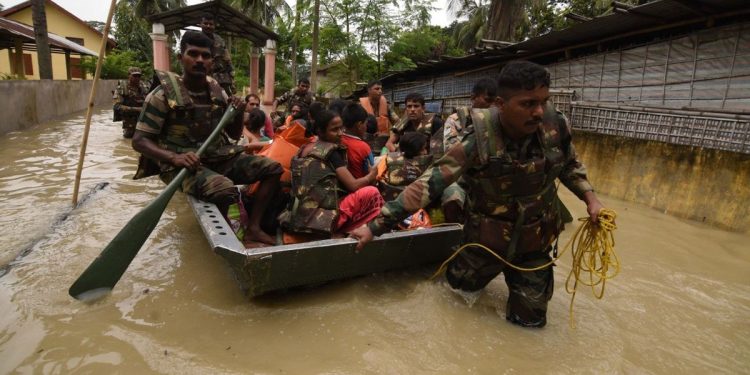New Delhi: As heavy rains continue to pound several states across India throwing life out of gear, environment experts have blamed climate change and rising global temperature for an erratic rainfall pattern which has claimed over 100 lives so far.
While some experts stress on reducing carbon footprint, some feel it is not a natural phenomenon but a result of unplanned construction.
Several parts of India are currently under water as a result of unusually heavy monsoon rains, with Uttar Pradesh and Bihar particularly affected. Nearly 110 people have died in the last five days. While 79 people have died in UP, 28 lives have been lost in Bihar.
Tarun Gopalakrishnan, climate policy researcher at the Centre for ‘Science and Environment’, said there is a need to reduce carbon emissions as climate change was resulting in erratic rains.
“Climate change is resulting in more erratic rainfall patterns, including a large portion of seasonal rainfall being concentrated in a limited number of days, leading to floods. Limiting the human cost of this trend will require drastically cutting carbon emissions around the globe, while investing in adaptation for the new climate reality,” stated Gopalakrishnan.
Scientists on the ‘Intergovernmental Panel on Climate Change’ (IPCC) said the rise in global and local temperatures have contributed to the observed anomalies in rainfall.
“Parts of Bihar and the Uttar Pradesh-Uttarakhand belt already exhibit a rising trend in terms of the number of heavy rainfall events. Though we cannot pinpoint each event to climate change unless we do in-depth attribution study, it is likely that the rise in global and local temperatures have contributed to observed anomalies in rainfall,” said Roxy Mathew Koll, co-author of IPCC’s special report on oceans and cryosphere.
Another co-author of the report, Anjal Prakash, said in the last week of September 2019, many parts of peninsular India (Hyderabad and Pune), coastal region (Kolkata, Gujarat, Goa, Machilipatnam and Vizag) and sub-Himalayan region (Assam, Meghalaya, Nagaland, Manipur, Mizoram, Tripura, Bihar, West Bengal, Sikkim, Uttarakhand and Himachal Pradesh) received heavy downpour leading to havoc.
“These areas have received rains unprecedented in recent history. The recent IPCC report has forecasted these variations due to changes in the ocean and cryosphere. More than 100 climate scientists have been involved in preparing the report that states the current knowledge on these climatic events by assessing more than 7000 published work,” Prakash said.
“Massive and unprecedented flood events will occur due to warming up of oceans leading to severity of extraordinary cyclonic events,” Prakash added.
However, an official from the India Meteorological Department (IMD) believed that the act of unplanned developmental activities carried out by humans was causing the havoc.
Refusing to blame climate change for the devastating floods occurring in the country, Anand Kumar Sharma, Deputy Director of Meteorology, IMD, said, the ‘real issue is change in land use and encroachments’.
“Climate change can be linked very easily but one has to see these real issues. The real issue is change in land use, land cover and unplanned development taking place in these areas. When river plains will be encroached upon and unplanned development will take place, then these calamities are bound to occur. People are building houses even in rivers plains now,” Sharma pointed out.
According to a climate science and policy institute based in Germany, the world has so far heated about 1°C since pre-industrial times and, around the world, heavy rainfall has increased.
An analysis found that there has been a threefold increase in widespread extreme rainfall over central India since 1950, as a result of warming in the northern Arabian Sea and that rainstorms in north India have become 50 per cent more common.
There is also a connection between the ‘El Niño’ climate cycle and drought in India. A recent UN climate science report warned that ‘El Niño’ and ‘La Niña’, the opposite pattern, are likely to become more extreme, particularly with continued high emissions.
PTI







































